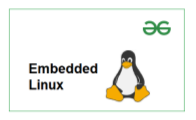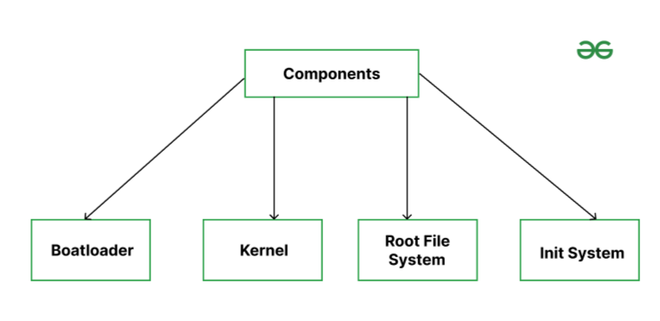Embedded Linux for IoT Systems
Last Updated :
07 Dec, 2023
Linux is a potent, open-source operating system based on Unix and capable of functioning on a variety of hardware with heavy operating demands. Earlier Linux was just an operating system, but over time, it has become one the best operating systems that support running desktops, embedded devices, and so on. The Linux OS is easy to maintain as it does not require any antivirus to protect because it doesn’t execute any single virus in any case.
Embedded Linux:

Embedded Linux
Embedded Linux is an open-source, dedicated edition of the Linux operating system for devices that we use daily. Embedded Linux is not a single product but a set of tools, libraries, and frameworks that allow the developer to create their operating system for the target devices. It is a standard version of Linux that has been developed to meet the needs of current technology with its efficient memory management and can fit in small hardware devices like Mobile phones, and smart wearable devices. It is designed to run on embedded systems such as smartphones, sensors, and other IoT devices. In simple terms, it can be customizable, which allows embedded Linux to fit the specific requirements of any embedded device. According to the current trend, embedded Linux is growing exceptionally due to some features as follows:
1. Cost-effectiveness
Embedded Linux is cost-effective because its solution is offered by Raspberry Pi 4, which comes with its own Raspberry Pi operating system. This makes the enticing choice for those who are looking to reduce productivity costs.
2. Community Support
Embedded Linux has a large community support. Since embedded Linux is often optimized for performance, reliability, security, and low power consumption. Developers continuously spread or share valuable knowledge about it.
3. Security
Embedded Linux can provide the best security among all OS if it has appropriate configuration and regular maintenance. While using Embedded Linux, defuses all needless services to avoid cyber-attacks or being hacked.
4. Scalability
Embedded Linux is highly scalable and able to run a wide range of devices with different memory sizes, storage capacities, and display resolution. Embedded Linux can also leverage the existing software ecosystem of Linux and cooperate with other operating systems and devices through standard protocols, interfaces, and reduced cost.
Are Linux and Embedded Linux are Same?
- These two are in some way related but not the same. Linux OS is used in desktops, servers, and embedded systems. In embedded systems, it is used as a real-time operating system. In the current market, there are lots of product that uses embedded Linux. Generally, the requirement of embedded Linux is different from Linux systems.
- In Linux, with the help of user and kernel space components are arranged to provide different features and compatibility with various hardware and software applications. But in Embedded Linux rather than seeking much help from user and kernel components, it majorly focused on reducing memory size and being customizable to accommodate any device and perform operations very effectively.
- The purpose of using Linux is to perform many tasks. let’s understand with examples of each.
- Example: Linux kernel is running in desktop is running several different applications for tasks running like running Videos, running google chrome, running GeekforGeeks app. So, we can see there are lots of tasks running on.
- But in the case of Embedded Linux, it is used for a particular task.
- Example: Linux kernel running in video streamer is doing the function of converting video format into MPEG4 and sending video stream on the network.
- Linux kernel footprint is more than 100MB, 1 MB1MB.
Components of Embedded Linux

Components of Embedded Linux
1. Bootloader
- When you power on your computer after performing some necessary setups, it will load the bootloader into memory and run that code.
- Its main task is to find the operating system’s binary program in memory and run the OS. The bootloader won’t run again until the computer is reset, or power cycled again.
- A bootloader is different from a typical laptop, desktop, or server computer. Embedded Linux uses DasUBoot or U-Boot for short as the bootloader.
2. Kernel
- The kernel is the fundamental part of an operating system. It is responsible for managing the resources and the communication between hardware and software components.
- Once the bootloader loads the Linux kernel into memory and runs it, the kernel will begin running its startup code.
- In embedded Linux where functionality can be activated depending on the needs, kernel becomes a very effective way of adding features without enlarging the image size.
3. Application
- Software applications are programs that utilize the capabilities and resources of a computer to do a specific task.
- The application makes use of hardware devices by communicating with device drivers, which are a part of the kernel.
4. Root File System
- The operating systems usually depend on the set of files and directories. The root file system is at the top of the hierarchical file tree.
- It contains some files and directories that are crucial for system operations, including the device directory and programs for booting the systems.
- The root file system also contains mount points where other file systems can be mounted to connect to the root file system hierarchy.
5. Init System
- It is the process to starts when a computer boots up and runs until the system shuts down.
- Init is the ultimate parent of all user space processes in a Linux system. It provides the default set of environment parameters for all other processes to inherit, including such things as PATH and CONSOLE.
- Its primary role is to generate extra processes under the guidance of a special configuration file.
Conclusion
Although Linux was not designed for embedded systems, through careful configuration and by using some of the work of the embedded Linux vendors. The future of embedded Linux appears bright, because of its flexibility, scalability, and its customizable property. In almost all embedded devices Linux is embedded and gives outstanding results.
Share your thoughts in the comments
Please Login to comment...